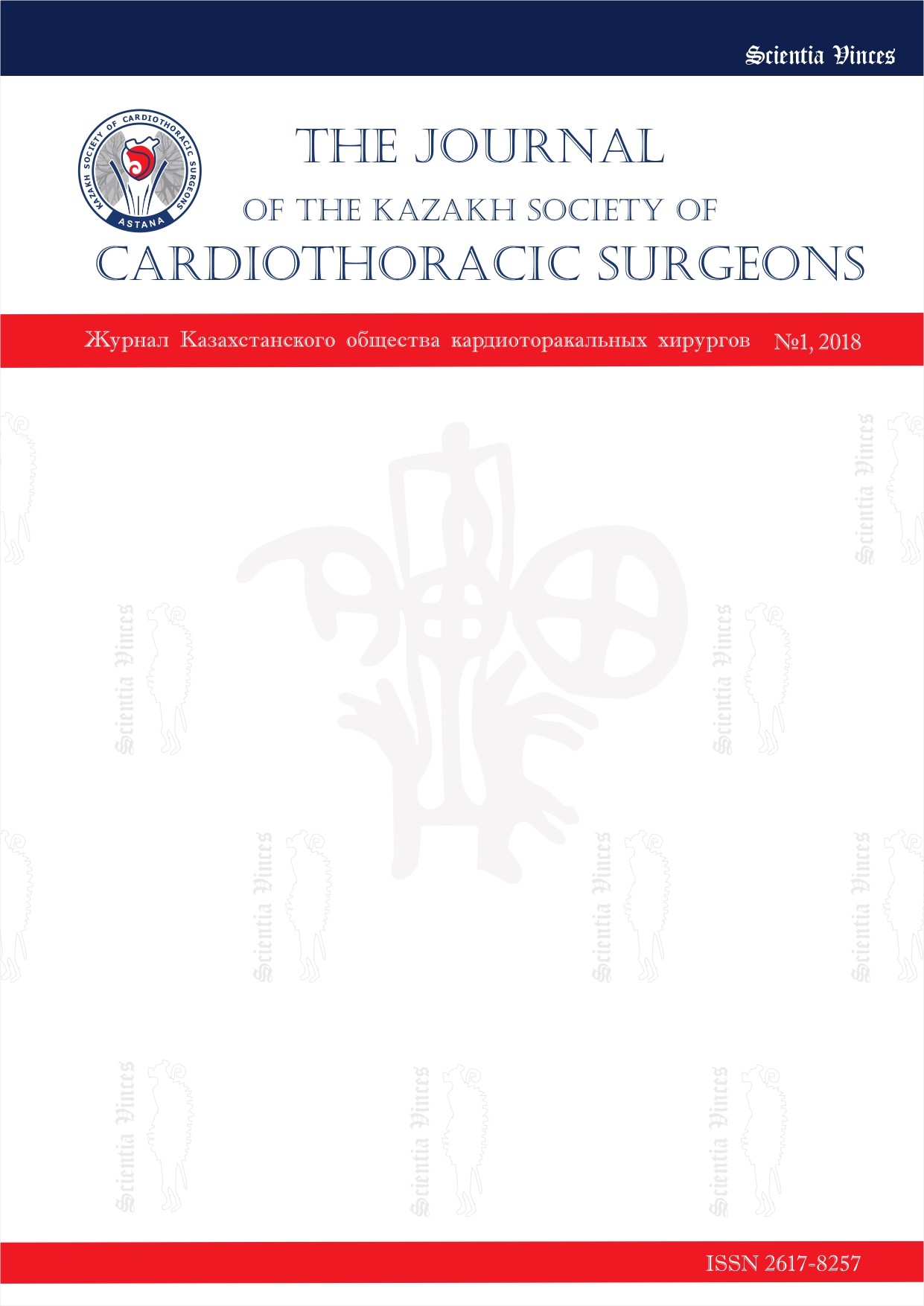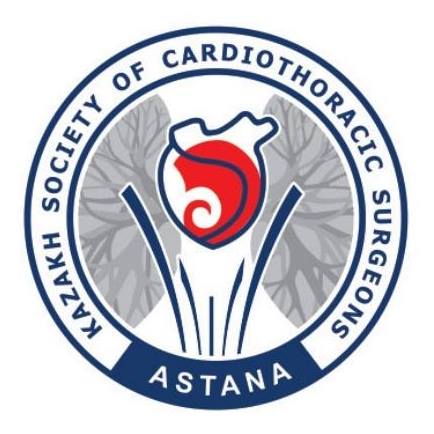Journal of the Kazakh Society of Cardiothoracic Surgeons

We are pleased to present to you the scientific and practical peer-reviewed Journal of the Kazakh Society of Cardiothoracic Surgeons (ISSN online 2706-7289). The Journal publishes topical research articles and unique clinical cases in cardiothoracic surgery. It was created to share experiences and, hence, improve the quality of treatment and the lives of patients.
The editorial board of the journal includes experts from Kazakhstan, the Commonwealth of Independent States and other foreign countries. A full list of reviewers is available on the first pages of each issue of the Journal, which you can find here.
There is no charge for publication and access to the magazine. The editorial team accepts articles in three languages: English, Russian and Kazakh. The Journal is published quarterly.
The first issue of the Journal of the Kazakh Society of Cardiothoracic Surgeons with all requirements for authors is available below.
Requirements for authors.
The editorial staff accepts articles that have never been published before and have not been submitted for publication in other journals.
The article can be presented in Russian, English or Kazakh languages.
Submitted articles undergo peer-reviewed process and can be returned to the authors for revision.
Rejected articles are not returned and are reconsidered for review.
The editors reserve the right to edit articles that do not distort their content.
The authors are responsible for the accuracy of the results of scientific results presented in the work.
1. Technical requirements
- Page format - A4, portrait.
- Font - Times New Roman.
- Font size - 12.
- Interval is 1.5.
- Alignment - in width.
- Margins - 2.5 cm.
- Page count - maximum 10 pages (without abstract).
- All pages of the text should be numbered.
- All measurements are given in the SI unit system.
- Expand all abbreviations at first mention on the text.
- Acceptable file formats: .doc, docx.
2. Title page
- On the title page of the article are indicated: the title of the article (abbreviations are not allowed in the title) Data about each author:
- The last name, first name and patronymic of each author (in full) with a superscript digital sign (in front of the last name) of the author’s affiliation;
- Affiliation of each author with a superscript number corresponding to a superscript digital sign in front of the author's name;
- Full name, address and telephone number of the institution on the basis of which the work was done (research institute, university, department, department, laboratory, hospital).
- E-mail of each author or institution, in which the author works.
- The title page is made in the language in which the article is written
3. Abstract
The article must have an abstract (maximum 250 words). Abstract should contain a brief description of the nature of the study with major findings, namely relevance, purpose of the work, design of the study, materials and methods, results, conclusions. Abstract and key words are issued in Kazakh (for foreign authors translation will be made by the editors), Russian and English.
4. The text of the original article should include following sections: introduction, materials and methods, results, discussion, conclusions and references.
- Introduction: the relevance of the issue should be disclosed, including its impact, as well as purpose and objectives of the work;
- Material and methods: the section should contain information about the design of the study, its duration, place, a description of statistical methods;
- Results: description and explanation of all obtained data with the statistical results, level of evidence (I or II), recommendations, or the need for further research on this topic;
- Discussion: the results should be discussed in terms of novelty and compared with known data;
- Conclusion: a brief description of the results of a scientific study. Conclusions should logically correspond to the objectives. Statements that are not supported by actual data should be avoided;
- Grants, sources of financial support, technical and other assistance are noted in the section “Funding” at the end of the text before the list of references.
5. Illustrative material
Illustrations (tables, graphs, diagrams, drawings, photographs) are presented as separate files in .jpeg, .tiff, .eps, .psd formats; legends - in a separate file in a .doc, .docx formats.
All tables should have clearly marked columns that are convenient and readable. These tables should correspond to the figures in the text, but should not duplicate the information presented in it.
Illustrations should be clear and sharp. It is unacceptable to draw any elements on top of the image (arrows, signatures) inserted into the manuscript file due to the high risk quality loss during publication stages.
The same type of illustrations should have equal size, scale, nature of the presentation of information. The name and explanation of the figure should be presented below (for figures) or in the top (for tables) of the illustration.
Radiographs, tomograms, ultrasonograms and other diagnostic images, as well as surgical and pathological anatomical preparations and micropreparations are presented in the form of contrasting black-and-white or (preferably) color photographs. Captions for photomicrographs should indicate the scale (degree of magnification) and the method of staining.
The figure captions (legends) must be printed on a separate sheet (in Word text editor, Times New Roman font, 12 pt, 1.5 line spacing, margins 2.5 cm, hyphenation in words and paragraph indents are automatic) and numbered with Arabic numerals in the order of the appearance of pictures in the text. At the end of each legend, you must specify (in alphabetical order) and decipher all abbreviations that are in the figures.
6. References
At the end of the article there must be list of references. Reference style is GOST. In-text citation of an article should be presented as ordinal number of the list in square brackets, [1].
In accordance with the requirements of international citation systems, authors of articles should submit References in the original language.
Example of a reference of journal article:
Larina V.N., Alekhin M.N., Bart B. Ya. Syndrome of functional mitral regurgitation in patients with chronic heart failure // Cardiology. - 2009. - T. 49. - №. 11. - p. 77-80.
Example of a reference of a document from website:
Analytical material of the extended board of the Ministry of Health of the Republic of Kazakhstan // https: //docplayer.ru/52018217-Analiticheskiy-material-rasshirennoy-kollegii-ministerstva-zdravoohraneniya.html. - 2017.
References include following information:
- for books: the surname and initials of the author, the name of the book, place of publication (city), name of the publisher, year, volume, page numbers;
- for journal articles: the author’s surname and initials, the title of the article, the title of the journal, year, volume, issue number, page numbers;
- for articles from collections of materials of scientific conferences: the surname and initials of the author, the title of the article, the title of the collection, the place of publication (city), year, page numbers in and out;
- дfor abstracts of dissertations: surname and initials of the author, name, place of publication (city), name of the publishing house, year, page numbers.
Unpublished works and textbooks should not be included in the list of references. When citing electronic materials, a link to the relevant Internet resources (electronic documents, databases, portals, websites, web pages, etc.) is necessary.
The original article recommends using at least 10 and no more than 30 reliable sources. The review article should contain no more than 50 sources (at least half - foreign sources). The list of references should contain at least 5 sources published over the past 2 years in periodicals with a high international citation index.
For questions you can contact us by e-mail kazscts@gmail.com, info@kazcts.kz or by phone +7 (7172) 70 31 53.
